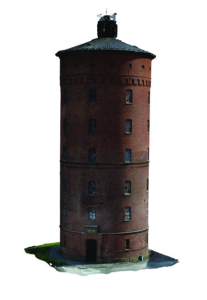-

Drones facilitates keeping the map database of Vänersborg up to date
Working with a drone is very effective. That’s what Map- and measurement engineer Cecilia Eriksson, at Vänersborg municipality, deem. The drone compliments other equipment and makes it possible to easily update the map database when the demand on accuracy isn’t that high.
Vänersborg is a very attractive municipality. A sign of that is the lively housing market.
– We sense a big interest in creating new plots and more apartment blocks, townhouses and other housings are built, Cecilia Eriksson, map- and measurement engineer at the Map- and Geodata function within the municipality, explains.
One of the reasons is the newly inaugurated double-track to Gothenburg, which saves commuters a lot of time.
Using a drone as a helping tool in the GIS-work facilitates in the current expansive spirit. But it’s a complement, Cecilia emphasize and explains that you usually use other equipment, like a total station and a GPS. The drone doesn’t possess the same accuracy as the data from a total station, but there’s still advantages.– It’s very effective to work with drones when you’re doing measurements with a lower demand on accuracy. Collecting information about a street segment or a bus stop no longer require us walking in traffic. It’s easy to fly above a trench or road and that contributes with quickly collected data to start the mapping.
Keeping the database up to date with drones
The drone has proven to be very useful to keep the municipal map database up to date. Especially when it’s about supplying new information. Map- and measurement engineer Robin Johansson is one of Cecilia’s colleagues and shares an example from the field.
– A couple of weeks ago we flew the drone over a detached area, which was built a few years ago. Now many of the house owners want to build conservatories and then we realized that the information we possessed was not up to date. All we had was the actual buildings and property lines. That’s when the drone flying is an effective way of collecting data regarding the properties’ appearances and keeping the map database up to date.
But the drone has its limits. It takes planning, permission for flying and it requires close contact with both airports, the military one and the civil one, located in the area. All to make sure the drone flying doesn’t cause any trouble. It’s also a question about precision. In order to produce building permit documents and similar acts millimeter accuracy is necessary and that would be a task for the total station.

Map database as an important source of information
The information transmits at the office which later on gets mapped directly into Topocad through the ESPA connection and the basis is later put in the map database. Then you’ve decided type of data and the relevance, which depends on the order you’ve received.
– We place our drone flying beneath the WMS service, in order for us to activate the flying in Topocad, Cecilia explains.
The GIS-information is processed, at the Map- and Geodata, to clients within and outside the municipality. Working there are, not only the map- and database engineers, but also GIS-engineers, a 3D-graphics and a responsible manager.
– To us, the map database is a substrate that we keep working with, Cecilia clarifies. It could be maps to the building permit process, which are supposed to be provided with plan information, or the GIS-engineers who are supposed to be able to read the map to make an analysis based on measured details.
Today most of the map material is placed in plans, but there’s an ambition to provide heights in order to get a basis in all three leads. That will facilitate future orders received by the 3D-graphics. The municipality’s spatial database contains nearly 1000 different layers, all from traditional layers like alignments and buildings, to more significant ones, like potential solar per building.
Visualizing with VR
At the moment, a school is under design and being rebuilt. The 3D-graphics is benefitting the rich information, provided by the point cloud, which is generated from the municipality’s aerial photographs of the area. Once the information from the database is combined with the generated point cloud and the drawings of the planned school you’ll have enough material to make a correct visualizing in VR, since the vegetation and the buildings nearby have the right height.
But it’s not only the GIS- and measurement specialists who can benefit Topocad. Other departments also use the program in order to collect data, such as information about a certain property in a certain errand. Using orthophoto, in one of the layers, the information content becomes richer, which eases it for the officials to make decisions and continue with the project.
– We’ve also built a dialogue tool, “My Vänersborg”, where the city is built in 3D. We’re currently using drone flying to create 3D models which are put in the dialogue tool. That’s also for the public to share feedback and wander virtually in the city.
Using the drone and other instruments enables it for Cecilia and her co-workers to get a hold of a rich source of GIS-data, where Topocad is a tool to transfer information to all parts of the growing municipality.